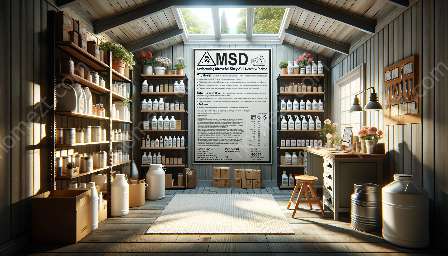Storage of hazardous materials poses various legal and regulatory challenges, particularly when it comes to ensuring home safety and security. It is important to comply with specific regulations related to the safe storage of hazardous materials to prevent potential risks and harm. This article addresses the key aspects of legal and regulatory considerations for hazardous material storage, providing insights into the requirements and best practices for safe storage of such materials.
Understanding Hazardous Materials
Hazardous materials are substances that can pose a risk to health, safety, or property when improperly handled or stored. These substances can include chemicals, gases, flammable materials, and other hazardous substances. Given their potential dangers, there are strict legal and regulatory guidelines that govern the storage and handling of such materials.
Legal Compliance for Home Safety and Security
When it comes to storing hazardous materials at home, homeowners need to be mindful of applicable laws and regulations. It is crucial to comply with local, state, and federal regulations governing the storage of hazardous materials to ensure the safety and security of the residential environment. Failure to adhere to these regulations can result in severe penalties and, more importantly, put individuals and property at risk.
Storage Facility Requirements
Depending on the type and quantity of hazardous materials being stored, there may be specific requirements for storage facilities. This can include considerations such as fire-resistant construction, ventilation, spill containment measures, and the need for specialized storage containers. It is essential to understand and meet these requirements to prevent accidents and minimize the potential impact of a hazardous material incident.
Regulatory Considerations
Government agencies, such as the Environmental Protection Agency (EPA), the Occupational Safety and Health Administration (OSHA), and local fire departments, enforce regulations related to hazardous material storage. These regulations cover various aspects, including labeling, packaging, transportation, and emergency response planning. It is imperative for individuals and organizations to stay informed about these regulations and implement necessary measures to remain compliant.
Safe Storage Practices
In addition to legal requirements, following safe storage practices is essential for mitigating the risks associated with hazardous materials. This includes proper labeling of containers, ensuring proper ventilation, implementing spill containment measures, and providing adequate training for individuals handling the materials. Establishing an effective emergency response plan and maintaining regular inspections further contribute to safe storage practices.
Integration with Home Safety & Security Measures
Considering the potential hazards that hazardous materials pose, it is crucial to integrate their storage with broader home safety and security measures. This can involve designing storage areas with fire-resistant materials, incorporating surveillance and monitoring systems, and ensuring that hazardous materials are stored away from ignition sources and potential risks of unauthorized access.
Professional Guidance and Support
Given the complexities of legal and regulatory considerations for hazardous material storage, seeking professional guidance and support can be valuable. Environmental consultants, safety experts, and legal advisors can provide insights into compliance requirements and help establish safe storage practices tailored to specific needs. Consulting with these professionals can mitigate risks and enhance overall safety and security measures.
Conclusion
Complying with legal and regulatory considerations for the safe storage of hazardous materials is vital for safeguarding home safety and security. By understanding the regulatory landscape, implementing safe storage practices, and integrating these measures with broader home safety and security initiatives, individuals and organizations can proactively mitigate potential hazards and ensure compliance with relevant regulations. Prioritizing safe storage of hazardous materials is not only a legal obligation but also a crucial aspect of responsible and secure household management.



